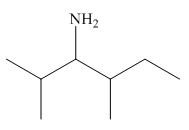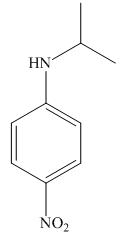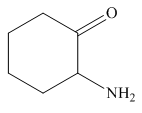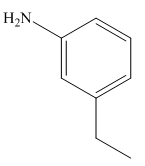
(a)
Interpretation: The structure corresponding to given compound is to be drawn.
Concept introduction:
1. The hydrocarbon is named after the longest carbon chain.
2. The parent hydrocarbon containing amino group is named as
3. When the nitrogen atom of amine is substituted with alkyl groups, then the amine is named with prefix
Answer to Problem 25.3P
The structure of the given compound is,

Explanation of Solution
The IUPAC name of the compound is

Figure 1
The structure of the given compound is shown in Figure 1.
(b)
Interpretation: The structure corresponding to given compound is to be drawn.
Concept introduction: IUPAC nomenclature is a systematic way of naming the organic compounds. The basic principles of IUPAC naming for hydrocarbon are:
1. The hydrocarbon is named after the longest carbon chain.
2. The parent hydrocarbon containing amino group is named as alkane with suffix amine.
3. When the nitrogen atom of amine is substituted with alkyl groups, then the amine is named with prefix
Answer to Problem 25.3P
The structure of the given compound is,

Explanation of Solution
The IUPAC name of the compound is

Figure 2
The structure of the given compound is shown in Figure 2.
(c)
Interpretation: The structure corresponding to given compound is to be drawn.
Concept introduction: IUPAC nomenclature is a systematic way of naming the organic compounds. The basic principles of IUPAC naming for hydrocarbon are:
1. The hydrocarbon is named after the longest carbon chain.
2. The parent hydrocarbon containing amino group is named as alkane with suffix amine.
3. When the nitrogen atom of amine is substituted with alkyl groups, then the amine is named with prefix
Answer to Problem 25.3P
The structure of the given compound is,

Explanation of Solution
The IUPAC name of the compound is

Figure 3
The structure of the given compound is shown in Figure 3.
(d)
Interpretation: The structure corresponding to given compound is to be drawn.
Concept introduction: IUPAC nomenclature is a systematic way of naming the organic compounds. The basic principles of IUPAC naming for hydrocarbon are:
1. The hydrocarbon is named after the longest carbon chain.
2. The parent hydrocarbon containing amino group is named as alkane with suffix amine.
3. When the nitrogen atom of amine is substituted with alkyl groups, then the amine is named with prefix
Answer to Problem 25.3P
The structure of the given compound is,

Explanation of Solution
The IUPAC name of the compound is

Figure 4
The structure of the given compound is shown in Figure 4.
(e)
Interpretation: The structure corresponding to given compound is to be drawn.
Concept introduction: IUPAC nomenclature is a systematic way of naming the organic compounds. The basic principles of IUPAC naming for hydrocarbon are:
1. The hydrocarbon is named after the longest carbon chain.
2. The parent hydrocarbon containing amino group is named as alkane with suffix amine.
3. When the nitrogen atom of amine is substituted with alkyl groups, then the amine is named with prefix
Answer to Problem 25.3P
The structure of the given compound is,

Explanation of Solution
The IUPAC name of the compound is

Figure 5
The structure of the given compound is shown in Figure 5.
(f)
Interpretation: The structure corresponding to given compound is to be drawn.
Concept introduction: IUPAC nomenclature is a systematic way of naming the organic compounds. The basic principles of IUPAC naming for hydrocarbon are:
1. The hydrocarbon is named after the longest carbon chain.
2. The parent hydrocarbon containing amino group is named as alkane with suffix amine.
3. When the nitrogen atom of amine is substituted with alkyl groups, then the amine is named with prefix
Answer to Problem 25.3P
The structure of the given compound is,

Explanation of Solution
The IUPAC name of the compound is

Figure 6
The structure of the given compound is shown in Figure 6.
(g)
Interpretation: The structure corresponding to given compound is to be drawn.
Concept introduction: IUPAC nomenclature is a systematic way of naming the organic compounds. The basic principles of IUPAC naming for hydrocarbon are:
1. The hydrocarbon is named after the longest carbon chain.
2. The parent hydrocarbon containing amino group is named as alkane with suffix amine.
3. When the nitrogen atom of amine is substituted with alkyl groups, then the amine is named with prefix
Answer to Problem 25.3P
The structure of the given compound is,

Explanation of Solution
The IUPAC name of the compound is

Figure 7
The structure of the given compound is shown in Figure 7.
(h)
Interpretation: The structure corresponding to given compound is to be drawn.
Concept introduction: IUPAC nomenclature is a systematic way of naming the organic compounds. The basic principles of IUPAC naming for hydrocarbon are:
1. The hydrocarbon is named after the longest carbon chain.
1. The parent hydrocarbon containing amino group is named as alkane with suffix amine.
2. When the nitrogen atom of amine is substituted with alkyl groups, then the amine is named with prefix
Answer to Problem 25.3P
The structure of the given compound is,

Explanation of Solution
The IUPAC name of the compound is

Figure 8
The structure of the given compound is shown in Figure 8.
Want to see more full solutions like this?
Chapter 25 Solutions
PKG ORGANIC CHEMISTRY
- Please complete the reactions, thank youarrow_forwardConsider the synthesis. What is compound Y? Please explain what is happening in this question. Provide a detailed explanation and a drawing to show how the compound Y creates the product. The correct answer is D.arrow_forwardWhat would be the major product of the following reaction? Please include a detailed explanation of what is happening in this question. Include steps and a drawing to show this reaction proceeds and how the final product is formed. The correct answer is B. I put answer D and I don't really understand what is going on in the question.arrow_forward
- What is the product of the following reaction? Please explain what is happening in this question. Provide a detailed explanation and a drawing showing how the reagent is reacting with the catalysts to product the correct product. The correct answer is B.arrow_forwardWhat is the missing intermediate 1 and the final product 2. Please include a detailed explanation explaining the steps of malonic ester synthesis. Please include drawings of the intermediate and how it occurs and how the final product is former.arrow_forwardWhat would be the reagents and conditions above and below the arrow that will complete the proposed acetoacetic ester synthesis? If it cannot be done efficiently, then I will choose that answer. There could be 2 or 4 reagents involved. Please provide a detailed explanation and drawings showing how it would proceed with the correct reagents.arrow_forward
- For benzene, the ∆H° of vaporization is 30.72 kJ/mol and the ∆S° of vaporization is 86.97 J/mol・K. At 1.00 atm and 228.0 K, what is the ∆G° of vaporization for benzene, in kJ/mol?arrow_forwardThe reaction Q(g) + R(g) → Z(l) is shown to be exothermic. Which of the following is true concerning the reaction. it is spontaneous only at High T, it is spontaneous at low T it is nonspontaneous at all T it is spontanrous at all T. it is non spontaneous only at low T.arrow_forwardThe reaction Q(g) + R(g) → Z(l) is shown to be exothermic. Which of the following is true concerning the reactionarrow_forward
- Which of the following has the largest standard molar entropy, S° (298.15 K) He H2 NaCl KBr Hgarrow_forwardWhich of the following is true for a particular reaction if ∆G° is -40.0 kJ/mol at 290 K and –20.0 kJ/mol at 390 K?arrow_forwardWhat is the major product of the following reaction? O O OH OH 1. BH 2. H₂O₂, NaOH OH OHarrow_forward
 ChemistryChemistryISBN:9781305957404Author:Steven S. Zumdahl, Susan A. Zumdahl, Donald J. DeCostePublisher:Cengage Learning
ChemistryChemistryISBN:9781305957404Author:Steven S. Zumdahl, Susan A. Zumdahl, Donald J. DeCostePublisher:Cengage Learning ChemistryChemistryISBN:9781259911156Author:Raymond Chang Dr., Jason Overby ProfessorPublisher:McGraw-Hill Education
ChemistryChemistryISBN:9781259911156Author:Raymond Chang Dr., Jason Overby ProfessorPublisher:McGraw-Hill Education Principles of Instrumental AnalysisChemistryISBN:9781305577213Author:Douglas A. Skoog, F. James Holler, Stanley R. CrouchPublisher:Cengage Learning
Principles of Instrumental AnalysisChemistryISBN:9781305577213Author:Douglas A. Skoog, F. James Holler, Stanley R. CrouchPublisher:Cengage Learning Organic ChemistryChemistryISBN:9780078021558Author:Janice Gorzynski Smith Dr.Publisher:McGraw-Hill Education
Organic ChemistryChemistryISBN:9780078021558Author:Janice Gorzynski Smith Dr.Publisher:McGraw-Hill Education Chemistry: Principles and ReactionsChemistryISBN:9781305079373Author:William L. Masterton, Cecile N. HurleyPublisher:Cengage Learning
Chemistry: Principles and ReactionsChemistryISBN:9781305079373Author:William L. Masterton, Cecile N. HurleyPublisher:Cengage Learning Elementary Principles of Chemical Processes, Bind...ChemistryISBN:9781118431221Author:Richard M. Felder, Ronald W. Rousseau, Lisa G. BullardPublisher:WILEY
Elementary Principles of Chemical Processes, Bind...ChemistryISBN:9781118431221Author:Richard M. Felder, Ronald W. Rousseau, Lisa G. BullardPublisher:WILEY





